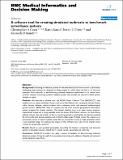A software tool for creating simulated outbreaks to benchmark surveillance systems
Author(s)
Cassa, Christopher A.; Iancu, Karin; Olson, Karen L.; Mandl, Kenneth D.
Download1472-6947-5-22.pdf (617.5Kb)
PUBLISHER_CC
Publisher with Creative Commons License
Creative Commons Attribution
Terms of use
Metadata
Show full item recordAbstract
Background: Evaluating surveillance systems for the early detection of bioterrorism is particularly challenging when systems are designed to detect events for which there are few or no historical examples. One approach to benchmarking outbreak detection performance is to create semi-synthetic datasets containing authentic baseline patient data (noise) and injected artificial patient clusters, as signal. Methods: We describe a software tool, the AEGIS Cluster Creation Tool (AEGIS-CCT), that enables users to create simulated clusters with controlled feature sets, varying the desired cluster radius, density, distance, relative location from a reference point, and temporal epidemiological growth pattern. AEGIS-CCT does not require the use of an external geographical information system program for cluster creation. The cluster creation tool is an open source program, implemented in Java and is freely available under the Lesser GNU Public License at its Sourceforge website. Cluster data are written to files or can be appended to existing files so that the resulting file will include both existing baseline and artificially added cases. Multiple cluster file creation is an automated process in which multiple cluster files are created by varying a single parameter within a user-specified range. To evaluate the output of this software tool, sets of test clusters were created and graphically rendered. Results: Based on user-specified parameters describing the location, properties, and temporal pattern of simulated clusters, AEGIS-CCT created clusters accurately and uniformly. Conclusion: AEGIS-CCT enables the ready creation of datasets for benchmarking outbreak detection systems. It may be useful for automating the testing and validation of spatial and temporal cluster detection algorithms.
Date issued
2005-07Department
Massachusetts Institute of Technology. Computer Science and Artificial Intelligence Laboratory; Massachusetts Institute of Technology. Department of Civil and Environmental EngineeringJournal
BMC Medical Informatics and Decision Making
Publisher
BioMed Central Ltd
Citation
BMC Medical Informatics and Decision Making. 2005 Jul 14;5(1):22
Version: Final published version
ISSN
1472-6947